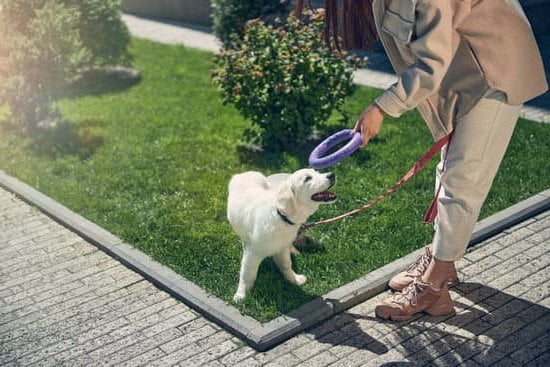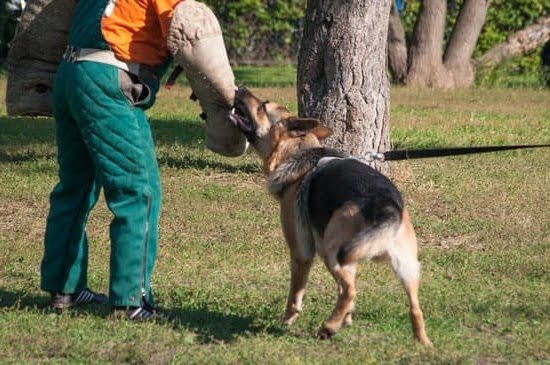Are you wondering how to train your dog to roll over? Teaching your furry friend this adorable trick can be a fun and rewarding experience for both of you.
Not only does it strengthen the bond between you and your dog, but it also provides mental stimulation and physical exercise. In this article, we will explore the benefits of teaching your dog to roll over, as well as provide a step-by-step guide to help you successfully train your pet.
Before diving into the training process, it’s important to establish trust and obedience with your dog. Basic training lays the foundation for more complex tricks like the roll over. We will discuss the importance of creating a positive and nurturing environment for your dog, which will ultimately lead to successful training sessions.
Additionally, choosing the right environment for training is crucial in ensuring that your dog is focused and receptive to learning. Identifying the best location and time for training sessions can greatly impact the effectiveness of the training process. We will cover tips on how to select an ideal training environment that encourages learning and reduces distractions for your pet.
Basic Training
Establishing a strong foundation of trust and obedience with your dog is essential before moving on to more complex tricks like the roll over. This section will cover key aspects of basic training that will create a positive learning environment for your furry friend.
Positive Reinforcement
Using positive reinforcement is one of the most effective methods for building trust and obedience in your dog. This includes using treats, toys, and praise to reward good behavior. When your dog associates performing a desired action with a positive outcome, they are more likely to repeat it.
Consistency and Patience
Consistency is crucial in basic training as it helps dogs understand what is expected of them. Set clear rules and boundaries, and be patient when teaching new commands. Avoid getting frustrated or raising your voice, as this can create fear or anxiety in your dog.
Building a Bond
Spending quality time with your dog outside of training sessions is important for strengthening the bond between you. Take walks, play games, and engage in activities that both you and your dog enjoy. A strong bond will make the training process more enjoyable for both of you and enhance overall obedience.
Choosing the Right Environment
When training your dog to roll over, choosing the right environment is crucial for a successful training session. The location and time of the training can greatly impact your dog’s focus and ability to learn. Here are some key considerations to keep in mind when identifying the best environment for training sessions:
- Distraction-free zone: Choose a quiet and enclosed space where your dog can concentrate without being easily distracted. This could be a room in your home or a fenced-in backyard.
- Comfortable temperature: Ensure that the training area is comfortable for your dog, especially if you are teaching them outdoors. Avoid extreme heat or cold that could make it difficult for your dog to focus.
- Time of day: Pick a time of day when your dog is most alert and energetic, such as after their mealtime or playtime. Avoid training during times when your dog is tired or easily distracted.
Additionally, it’s important to consider the specific needs and preferences of your own dog when choosing the environment for training sessions. Some dogs may do better with minimal distractions, while others may benefit from exposure to controlled distractions as part of their learning process.
By selecting the right environment for training sessions, you can set the stage for effective and enjoyable roll over training for both you and your furry friend. Remember that every dog is different, so be flexible and willing to adjust your approach based on what works best for your individual pet.
Preparing Your Dog
Before teaching your dog how to roll over, it’s essential to ensure that they are physically and mentally prepared for the training. Engaging in exercises and warm-up techniques can help your dog feel more comfortable and ready to learn the roll over command. Here are some key ways to prepare your dog:
1. Stretching exercises: Just like humans, dogs can benefit from stretching exercises before engaging in physical activity. Gently stretch your dog’s legs, back, and neck to loosen their muscles and prevent any strain during training.
2. Mental stimulation: Before starting the training session, engage your dog in mental stimulation activities such as playing with interactive toys or solving simple puzzles. This will help them focus and be more receptive to learning new commands.
3. Basic obedience practice: Make sure that your dog is responsive to basic obedience commands such as “sit” and “stay” before moving on to teaching them how to roll over. This will establish a foundation of trust and understanding between you and your pet, making it easier for them to learn more complex tricks.
By incorporating these preparation techniques into your training routine, you can set your dog up for success when learning the roll over command. Remember to be patient and provide positive reinforcement throughout the process.
Step-by-Step Guide to Teaching Roll Over
Training your dog to roll over can be a fun and rewarding experience for both you and your furry companion. It’s important to remember that teaching this trick requires patience, consistency, and positive reinforcement. Following a step-by-step guide can make the training process easier and more effective.
Start by practicing basic commands such as “sit” and “stay” before introducing the roll over command. This will help build trust and obedience between you and your dog, creating a solid foundation for learning new tricks. Once your dog is comfortable with these basic commands, you can move on to teaching the roll over.
The first step in teaching the roll over command is to use verbal cues accompanied by hand signals to guide your dog through the motion. Begin by having your dog lie down, then show them a treat or toy and use it to lure them into rolling onto their back.
As soon as they complete the roll over, reward them with plenty of praise and treats. Consistently practicing this sequence will help reinforce the behavior, eventually allowing your dog to perform the command without the need for lures or rewards.
| Training Step | Description |
|---|---|
| Build trust and obedience | Establishing trust and obedience with basic commands like sit and stay before introducing new tricks. |
| Use verbal commands and hand signals | Teaching your dog to respond to verbal cues accompanied by hand signals for guidance. |
| Positive reinforcement | Rewarding successful attempts at rolling over with praise, treats, or toys as positive reinforcement. |
Troubleshooting
Teaching your dog to roll over can come with its own set of challenges and setbacks. It’s important to be patient and understand that every dog learns at their own pace. One common challenge is the lack of motivation or interest from your dog.
If you’re facing this issue, try using high-value treats or toys to encourage your dog during training sessions. Additionally, make sure that you are in a positive and energetic mood during training, as dogs can pick up on your emotions.
Another common setback is when a dog becomes easily distracted during training sessions. If your dog loses focus, try changing the training environment or using shorter, more frequent training sessions to keep their attention. It’s also important to eliminate any potential distractions such as loud noises or other animals in the vicinity.
Some dogs may also struggle with physical limitations when learning to roll over. For example, larger breeds or senior dogs may find it uncomfortable or challenging to perform the maneuver. In such cases, it’s crucial to consult with a veterinarian to ensure that your dog is physically capable of performing the trick without causing any harm or discomfort.
| Common Challenge | Solution |
|---|---|
| Lack of motivation/interest | Use high-value treats or toys, maintain positivity and energy during training |
| Easily distracted | Change training environment, use shorter sessions, eliminate distractions |
| Physical limitations | Consult a veterinarian to ensure safety and comfort for larger breeds or senior dogs |
Advancing the Trick
Adding Distractions
Once your dog has mastered the basic roll over command in a controlled environment, it’s time to start adding distractions. This can include people walking by, other pets in the vicinity, or even toys and treats placed nearby.
By adding distractions, you are teaching your dog to focus on the command regardless of what else is happening around them. Start with small distractions and gradually increase the level of difficulty as your dog becomes more confident with the roll over command.
Using Different Surfaces
Another way to advance the trick is by practicing roll over on different surfaces. Start with a familiar surface such as grass or carpet, and then gradually introduce new surfaces like hardwood floors or concrete. Each surface will require slightly different coordination from your dog, allowing them to generalize the roll over command in various environments. Be patient and provide extra reinforcement during this process to help your dog feel comfortable and confident on different surfaces.
Adding Verbal Cues
Once your dog has mastered the physical movement of rolling over, you can start adding verbal cues to the command. This can include phrases like “roll” or “turn around,” which will signal to your dog that it’s time to perform the trick.
Pairing these verbal cues with hand signals will further solidify the roll over command in your dog’s training repertoire. Remember to be consistent with your cues and provide plenty of positive reinforcement as your dog learns to associate the verbal cues with the physical action.
Practicing and Patience
In conclusion, training your dog to roll over can be a fun and fulfilling experience for both you and your furry friend. By following the step-by-step guide provided and incorporating the tips and techniques outlined in this article, you can successfully teach your dog this impressive trick.
Remember that patience is key when it comes to training any new behavior, and this holds true for teaching your dog to roll over. Consistent practice, positive reinforcement, and a calm, patient demeanor will go a long way in helping your dog master this command.
It’s important to keep in mind that not all dogs will learn at the same pace, so it’s crucial to be understanding of your pet’s individual learning style. Some dogs may pick up on the roll over command quickly, while others may require more time and repetition.
Regardless of the speed at which your dog learns, it’s essential to avoid becoming frustrated or impatient during training sessions. Remember that every dog is unique, and with dedication and consistency, you will see progress over time.
Lastly, once your dog has mastered the basic roll over command, don’t hesitate to advance the trick by adding variations or increasing the difficulty. This will not only challenge your pet mentally but also strengthen the bond between you as you work together to achieve new goals. With plenty of practice and patience, your dog will soon be rolling over on command like a pro.
Frequently Asked Questions
What Is the Easiest Way to Teach a Dog to Roll Over?
The easiest way to teach a dog to roll over is through positive reinforcement and consistency. Start by luring the dog into a rolling position with a treat, then reward them when they successfully complete the roll.
Repeat this process while adding a verbal cue, such as “roll over,” and gradually phase out the lure as the dog becomes more comfortable with the command.
Why Does My Dog Refuse to Roll Over?
There could be several reasons why a dog might refuse to roll over. It’s possible that they simply haven’t been properly trained or have not associated the command with a positive outcome.
Some dogs may also feel uncomfortable or anxious in certain positions, so it’s important to approach training with patience and understanding of their individual behavior and needs.
What Is the Hand Signal for Roll Over Dog?
The hand signal for “roll over” in dog training typically involves using your hand to guide the dog’s motion in a rolling movement from side to side. This visual cue should be paired with the verbal command and used consistently during training sessions to help reinforce the desired behavior.
Over time, the dog will learn to associate both the hand signal and the verbal cue with rolling over on command.

Welcome to the blog! I am a professional dog trainer and have been working with dogs for many years. In this blog, I will be discussing various topics related to dog training, including tips, tricks, and advice. I hope you find this information helpful and informative. Thanks for reading!





